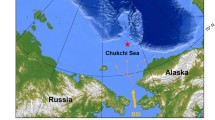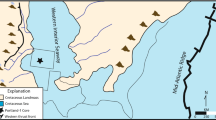Abstract
The environmental conditions and the biotic crisis during the Permo-Triassic (Tr/P) transition received increasing attention in the past decades. Presented herein are the molecular fossil records of cyanobacteria and green sulfur bacteria, the base of the marine ecosystem, to highlight the episodic nature of both the environment and the biotic crisis during this critical period. At least two episodes of cyanobacterial expansion are documented by 2-methylhopanes ranging from C28 to C32 in carbon number, indicative of the instable marine ecosystem and the fluctuant aquatic nutrients. Meanwhile, the index of 2-alkyl-1,3,4-trimethylbenzenes (biomarkers of green sulfur bacteria) and the ratio of pristane to phytane (Pr/Ph) witness the fluctuation of sedimentary environmental redox conditions. The above molecular evidence suggests the occurrence of highly fluctuating environmental conditions during the Tr/P transition, which is consistent with, and probably the cause of, the multi-phased biotic crisis and the prolonged faunal recovery.
Similar content being viewed by others
References
Yang Z, Wu S, Yin H, et al. Permo-Triassic Events of South China. Beijing: Geological Publishing House, 1993
Yin H, Tong J. Multidisciplinary high-resolution correlation of the Permo-Triassic boundary. Palaeogeogr Palaeoclimatol Palaeoecol, 1998, 143: 199–212
Erwin D H, Bowring S A, Jin Y. End-Permian mass extinctions: a review. In: Koeberl C & MacLeod K G, eds. Special paper 356, Catastrophic Events and Mass Extinctions: Impacts and Beyond. Boulder: Geological Society of America, 2002. 363–383
Jin Y, Wang Y, Wang W, et al. Pattern of marine mass extinction near the Permian-Triassic Boundary in South China. Science, 2000, 289: 432–436
Fang Z J. The pattern of the mass extinction, the change of the global ecosystem and its causes during the Permian-Triassic transition. In: Rong J Y & Fang Z J, eds. Mass Extinction and Recovery-Evidence from the Palaeozoic and Triassic of South China (in Chinese with English abstract). Hefei: China University of Science and Technology Press, 2004. 785–928
Wang H M, Xie S C, Lai X L, et al. Evaluation of the methodology in molecular geomicrobiology. Advan Earth Sci (in Chinese with English abstract), 2005, 20(6): 664–670
Grice K, Cao C, Love G D, et al. Photic zone euxinia during the Permian-Triassic superanoxic event. Science, 2005, 307: 706–709
Xie S, Pancost R D, Yin H, et al. Two episodes of microbial change coupled with Permo/Triassic faunal mass extinction. Nature, 2005, 434: 494–497
Summons R E, Jahnke L L, Hope J M, et al. 2-methylhopanoids as biomarkers for cyanobacterial oxygenic photosynthesis. Nature, 1999, 400: 554–557
Brocks J J, Buick R, Logan G A, et al. Composition and syngeneity of molecular fossils from the 2.78 to 2.45 billion-year-old Mount Bruce Supergroup, Pilbara Craton, western Australia. Geochim Cosmochim Acta, 2003, 67: 4289–4319
Farrimond P, Talbot H M, Watson D F, et al. Methylhopanoids: molecular indicators of ancient bacteria and a petroleum correlation tool. Geochim Cosmochim Acta, 2004, 68: 3873–3882
Wang P R. The Mass Chromatogram Atlas of Biomarkers (in Chinese). Beijing: Petroleum Industrial Press, 1993. 41
Rohmer M, Bouvier-Nave P, Ourisson G. Distribution of hopanoids triterpenes in prokaryotes. J Gen Microbiol, 1984, 130: 1137–1150
Simonin P, Jürgens U J, Rohmer M. Bacterial triterpenoids of the hopane seriels from the prochlorophyte Prochlorothrix hollandica and their intracellular location. Eur J Biochem, 1996, 241: 865–871
Knani M, Corpe W A, Rohmer M. Bacterial hopanoids from pink-pigmented facultative methylotrophs and from green plant surfaces. Microbiology, 1994, 140: 2755–2759
Vilchèze C, Llopiz P, Neunlist S, et al. Prokaryotic triterpenoids: new hopanoids from the nitrogen-fixing bacteria Azotobacter vinelanii, Beijerinckia indica and Beijerinckia mobilis. Microbiology, 1994, 140: 2749–2753
Renoux J M, Rohmer M M. Prokaryotic triterpenoids. New bacteriahopane tetrol cyclic ethers from methylotrophic bacteria Methylobacterium organophilum. Eur J Biochem, 1985, 151: 405–410
Chen Z. Extinction-Survival-Recovery of brachiopod faunas during the Permian-Triassic transition. Albertiana, 2005, 33: 23–26
Woods A D, Bottjer D J, Mutti M, et al. Lower Triassic large sea floor carbonate cements: their origin and a mechanism for the prolonged biotic recovery from the end Permian mass extinction. Geology, 1999, 27(7): 645–648
Zuo J X, Tong J N, Qiu H O, et al. Carbon and oxygen isotopic stratigraphic correlation and its paleoenvironment significance during the lower Triassic, Chaohu, Anhui Province, China. Chin J Geol Geochem (in Chinese with English abstract), 2003, 31(3): 26–33
Zuo J X, Tong J N, Qiu H O, et al. Carbon and oxygen isotope stratigraphy of the lower Triassic at northern Pingdingshan section of Chaohu, Anhui Province, China. Chin J Stratigr (in Chinese with English abstract), 2004, 28(1): 35–41
Bowring S A, Erwin D H, Jin Y G, et al. U/Pb zircon geochronology and tempo of the end Permian mass extinction. Science, 1998, 280: 1039–1045
Erwin D H. Life’s downs and ups. Nature, 2000, 404: 129–131
Summons R E, Powell T G. Chlorobiaceae in Palaeozoic sea revealed by biological markers, isotopes and geology. Nature, 1986, 319: 763–765
Summons R E, Powell T G. Identification of aryl isoprenoids in source rock and crude oils: biological markers for the green sulphur bacteria. Geochim Cosmochim Acta, 1987, 51: 557–566
Koopmans M P, Köster J, van Kaam-Peters H M E, et al. Diagenetic and catagenetic products of isorenieratene: molecular indicators for photic zone anoxia. Geochim Cosmochim Acta, 1996, 60: 4467–4496
Schwark L, Frimmel A. Chemostratigraphy of the posidonia black shale, SW-Germany II. Assessment of extent and persistence of photic-zone anoxia using aryl isoprenoid distributions. Chem Geol, 2004, 206: 231–248
Xie S, Pancost R D, Huang X, et al. Molecular and isotopic evidence for episodic environmental change across the Permo/Triassic boundary at Meishan in South China. Global and Planetary Change, 2007. 55(1): 56–65
Luo G M, Lai X L, Jiang H S, et al. Size variation of the end Permian conodont Neogondolella at Meishan Section, Changxing, Zhejiang and its significance. Sci China Ser D-Earth Sci, 2006, 49(4): 337–347
Author information
Authors and Affiliations
Corresponding author
Additional information
Supported by the National Natural Science Foundation of China (Grant Nos. 40525008 and 40232025) and NCET Program of Ministry of Education of China (Grant No. NCET-04-0729) and Fok Ying Tung Education Foundation
Rights and permissions
About this article
Cite this article
Huang, X., Jiao, D., Lu, L. et al. The fluctuating environment associated with the episodic biotic crisis during the Permo/Triassic transition: Evidence from microbial biomarkers in Changxing, Zhejiang Province. SCI CHINA SER D 50, 1052–1059 (2007). https://doi.org/10.1007/s11430-007-0024-x
Received:
Accepted:
Issue Date:
DOI: https://doi.org/10.1007/s11430-007-0024-x




